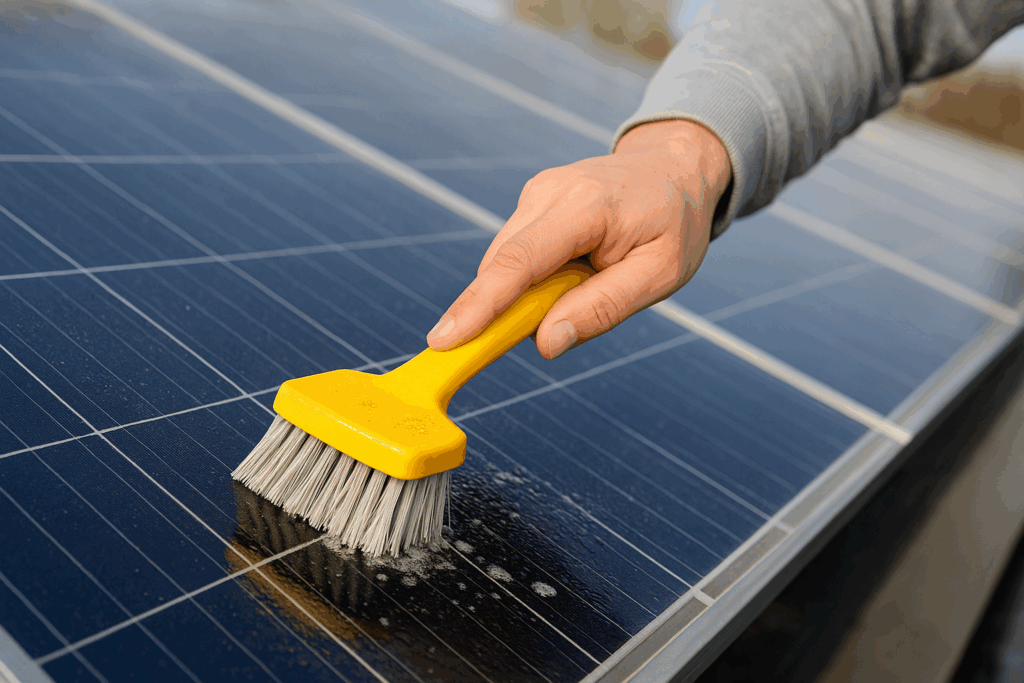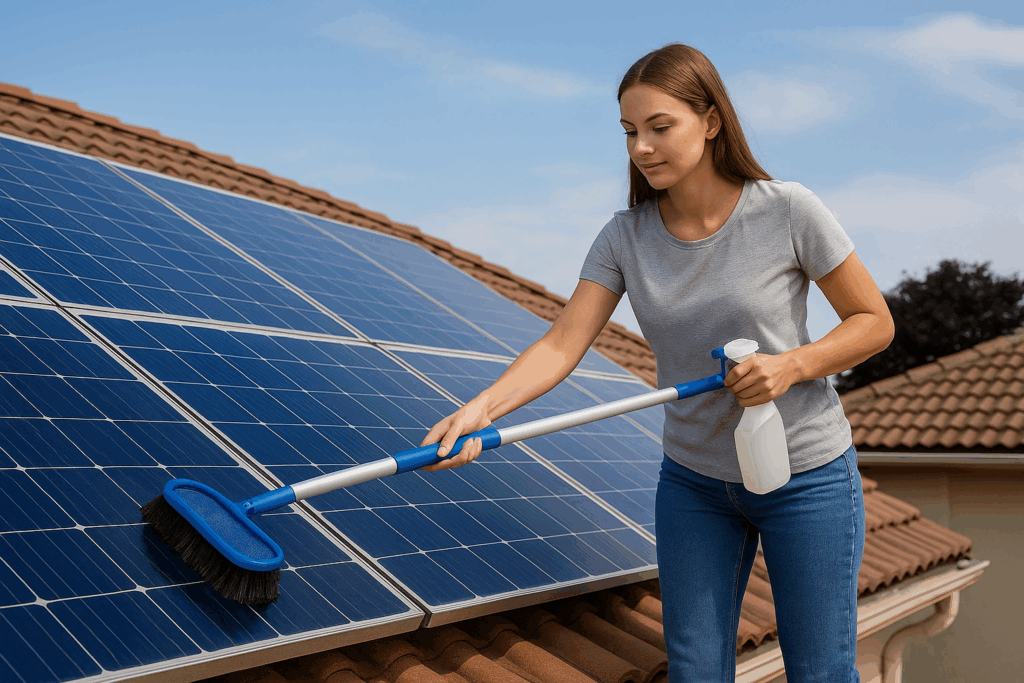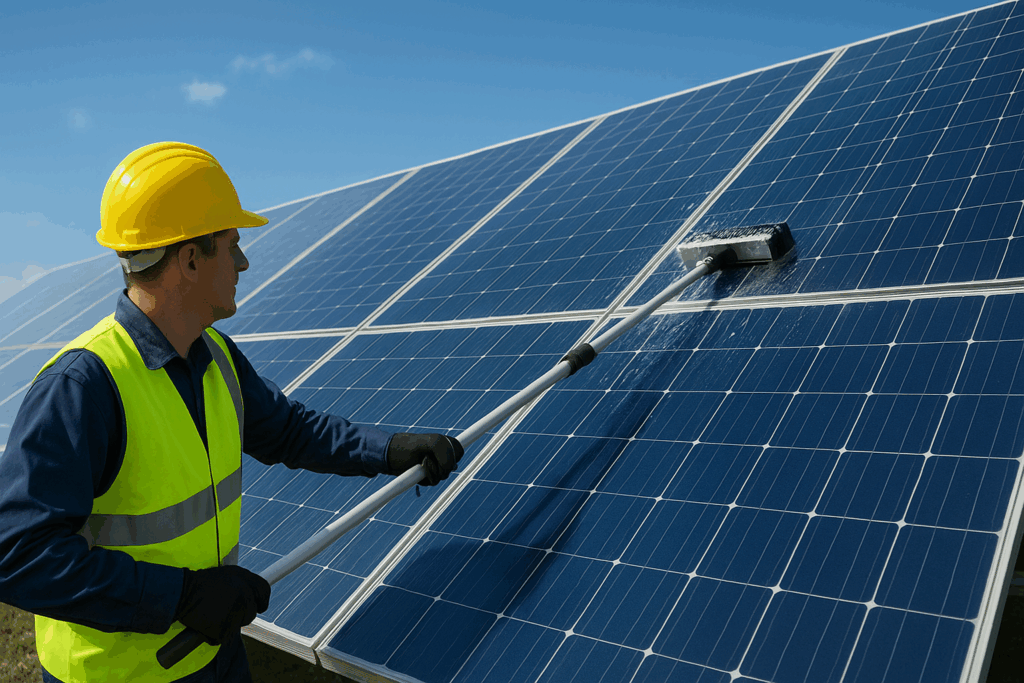Clean solar panels = more energy! 🌞 Over time, dust, pollen, bird droppings, and pollution reduce panel efficiency by up to 30%. Regular solar panel cleaning is crucial to maintain power output and system longevity.
This guide reveals 12 smart solar panel cleaning tricks to help boost your system’s performance, save money, and protect your solar investment.
☀️ 1. Use Soft, Non-Abrasive Brushes
Your solar panels have a delicate glass surface. Using harsh tools can cause scratches that reduce efficiency.
Tips:
- Use microfiber brushes or soft sponges.
- Avoid metal or hard plastic brushes.
- Combine with mild soap for stubborn dirt.
✅ Bonus: Keep a separate brush just for solar panel cleaning to avoid cross-contamination.
🌅 2. Clean Panels Early Morning or Late Evening
Temperature and timing matter! Cleaning hot panels during peak sun can cause cracks or streaks.
Why it’s important:
- Cooler temperatures prevent glass stress.
- Less water evaporation = better cleaning.
- Safer and more comfortable to work.
🕕 Best times: 6–8 AM or 6–8 PM
💧 3. Use Distilled or Deionized Water
Using distilled water helps avoid mineral stains. Tap water often leaves residue that attracts dust.
Benefits:
- Prevents calcium buildup.
- Ensures a spotless finish.
- Extends lifespan of panels.
DIY Tip: You can install a small water filter system to make your own deionized water for solar panel cleaning.
⚠️ 4. Avoid Harsh Soaps or Chemicals
Never use bleach or ammonia — they damage coatings. Go for mild soap or eco-friendly solar panel cleaners.
Eco-safe alternatives:
- 1 tsp mild dish soap in 1 gallon of warm water.
- Commercial solar-safe solutions (non-toxic, biodegradable).
Always rinse thoroughly to prevent sticky residue.
🚿 5. Use a Hose Rinse for Light Dust
If panels only have a light dust layer, a gentle hose rinse works perfectly.
Steps:
- Set your hose to low pressure.
- Rinse top-down for even coverage.
- Let panels air dry.
Avoid: Pressure washers — they can crack glass or loosen wiring.

🐦 6. Remove Bird Droppings and Tree Sap Regularly
Bird droppings block sunlight and must be cleaned promptly.
How to remove:
- Spray warm water and wait a few minutes.
- Gently scrub with a soft cloth.
- Avoid scraping tools.
Prevention tips:
- Install bird spikes or deterrents.
- Trim nearby trees to reduce sap.
⚙️ 7. Install a Self-Cleaning System
Automated solar panel cleaning systems save time and water.
Why they’re great:
- Ideal for large or rooftop installations.
- Operate automatically using sprinklers or robotic arms.
- Reduce manual labor.
Comparison Table:
| Cleaning Type | Cost | Maintenance | Efficiency Gain | Ideal Use |
|---|---|---|---|---|
| Manual Cleaning | Low | High | Moderate | Small homes |
| Automatic System | Medium | Low | High | Big setups |
| Professional Service | High | Minimal | Very High | Commercial sites |
🧽 8. Hire Professional Cleaners Annually
Even with regular care, experts are needed for a deep clean.
Benefits:
- Safe handling of electrical systems.
- Detect damage or corrosion early.
- Use specialized solar-safe solutions.
💰 Cost: ₹500–₹1500 (India) / $50–$150 (US)
Professional solar panel cleaning once a year keeps panels at peak output.

⚡ 9. Track Energy Output Before and After Cleaning
Check your inverter readings or app before and after cleaning.
| Date | Output Before | Output After | Gain (%) |
|---|---|---|---|
| 10 Oct | 15.2 kWh | 18.3 kWh | +20.3% |
Tracking confirms that regular solar panel cleaning genuinely improves performance.
🧴 10. Apply Anti-Static Coating
Anti-static coatings prevent dust and water buildup.
Advantages:
- Reduces cleaning frequency by 40%.
- Keeps panels looking new.
- Adds UV protection.
Apply every 6–8 months for lasting protection.
🪜 11. Stay Safe During Cleaning
Safety first during any solar panel cleaning job.
Checklist:
- Wear gloves, harness, and non-slip shoes.
- Use stable ladders or telescopic poles.
- Turn off your inverter before cleaning.
| Safety Gear | Purpose |
|---|---|
| Gloves | Protects hands |
| Safety Harness | Prevents falls |
| Ladder | Roof access |
| Goggles | Eye safety |
📘 12. Keep a Cleaning Logbook
Maintaining a cleaning record helps identify patterns and track performance.
What to log:
- Date & time
- Method used
- Tools & materials
- Power output before & after
Example: 12 Oct 2025 – Hose rinse & microfiber cloth – +18% output gain

💧 Bonus Tip: Use Rainwater Harvesting
Rainwater is naturally soft and free of minerals — ideal for solar panel cleaning.
Install a filter on your gutter system to store clean water for eco-friendly maintenance.
🚫 Common Mistakes to Avoid
- Cleaning during peak sunlight.
- Using pressure washers.
- Standing on panels.
- Skipping safety gear.
- Using tap water with minerals.
🌎 Maintenance Frequency Chart
| Location Type | Frequency | Reason |
|---|---|---|
| Urban | Every 3 months | Pollution, dust |
| Rural | Every 4–6 months | Pollen & debris |
| Coastal | Every 2 months | Salt buildup |
| Industrial | Every 1–2 months | Heavy soot |
🙋 Frequently Asked Questions (FAQs)
1. How often should I clean my solar panels?
Ideally every 3–4 months, depending on dust and weather. In coastal or industrial zones, do solar panel cleaning every 2 months.
2. Can I clean solar panels myself?
Yes, use mild soap, soft brushes, and a hose. Avoid climbing on the roof without safety gear.
3. Do solar panels need professional cleaning?
Once a year, yes. Professionals detect hidden issues and ensure deep, safe cleaning.
4. Can rain clean solar panels effectively?
Light rain helps rinse dust but doesn’t remove bird droppings or grime. Manual solar panel cleaning is still necessary.
5. What’s the best water for cleaning solar panels?
Always use distilled or deionized water to avoid streaks and mineral deposits.
Conclusion
Regular solar panel cleaning is the secret to sustaining peak energy output and efficiency. By following these 12 smart cleaning tricks, you’ll boost power, save on energy costs, and make your solar system last for years.
Clean panels = powerful panels 🌞
{ “@context”: “https://schema.org”, “@type”: “FAQPage”, “mainEntity”: [ { “@type”: “Question”, “name”: “How often should I clean my solar panels?”, “acceptedAnswer”: { “@type”: “Answer”, “text”: “Clean your solar panels every 3–4 months, or more frequently if you live in coastal or dusty regions.” } }, { “@type”: “Question”, “name”: “Can I clean solar panels myself?”, “acceptedAnswer”: { “@type”: “Answer”, “text”: “Yes, use mild soap, soft brushes, and a hose for safe DIY solar panel cleaning. Always prioritize roof safety.” } }, { “@type”: “Question”, “name”: “Do solar panels need professional cleaning?”, “acceptedAnswer”: { “@type”: “Answer”, “text”: “It’s recommended to hire professionals once a year to ensure deep cleaning and detect any technical issues.” } }, { “@type”: “Question”, “name”: “Can rain clean solar panels effectively?”, “acceptedAnswer”: { “@type”: “Answer”, “text”: “Rain can rinse light dust but cannot remove grime or bird droppings. Manual cleaning is still necessary.” } }, { “@type”: “Question”, “name”: “What’s the best water for cleaning solar panels?”, “acceptedAnswer”: { “@type”: “Answer”, “text”: “Use distilled or deionized water to prevent streaks and mineral buildup after solar panel cleaning.” } } ] } { “@context”: “https://schema.org”, “@type”: “HowTo”, “name”: “12 Smart Solar Panel Cleaning Tricks to Boost Power”, “description”: “A detailed guide explaining how to safely and effectively clean solar panels to maximize energy efficiency.”, “image”: “https://example.com/solar-panel-cleaning.jpg”, “totalTime”: “PT2H”, “estimatedCost”: { “@type”: “MonetaryAmount”, “currency”: “USD”, “value”: “15” }, “supply”: [ { “@type”: “HowToSupply”, “name”: “Soft brush” }, { “@type”: “HowToSupply”, “name”: “Mild soap” }, { “@type”: “HowToSupply”, “name”: “Distilled water” } ], “tool”: [ { “@type”: “HowToTool”, “name”: “Hose” }, { “@type”: “HowToTool”, “name”: “Microfiber cloth” } ], “step”: [ { “@type”: “HowToStep”, “name”: “Rinse Panels”, “text”: “Use a hose to gently rinse off dust from the panels.” }, { “@type”: “HowToStep”, “name”: “Scrub Gently”, “text”: “Use a soft brush and mild soap to remove stubborn dirt.” }, { “@type”: “HowToStep”, “name”: “Rinse with Distilled Water”, “text”: “Finish by rinsing the panels with distilled or deionized water for a streak-free finish.” }, { “@type”: “HowToStep”, “name”: “Dry and Inspect”, “text”: “Let panels air dry and inspect for damage or residue.” } ] }